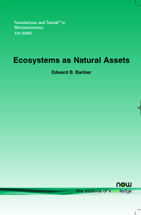Ecosystems as Natural Assets
By Edward B. Barbier, Department of Economics & Finance, University of Wyoming, USA, ebarbier@uwyo.edu
Abstract
It is now standard in economics to model natural resources as a special form of capital that can be depleted or accumulated. The following review shows how such an approach can be extended to ecosystems, implying that they are a form of natural asset that produces a flow of beneficial goods and services over time. The review includes a discussion of valuing ecosystem services, focusing on the problem of benefits that vary spatially across landscapes and illustrated with the example of coastal ecosystems. The starting point of the basic natural asset model is the assumption that any ecological landscape that is conserved must compete with other assets in the portfolio of wealth owners in the economy. The model shows the importance of valuing ecosystem services to the optimal allocation of landscape among competing uses. It includes the possibility of an ecological transition, when it becomes technologically feasible to restore developed land as ecological landscape. The basic model is then extended to allow for the value of an ecosystem service and the costs of maintaining this service to vary with the spatial distance across the natural landscape; for the implications when the economy is opened to trade; and finally, for examining the effects of the risk of ecological collapse.
Ecosystems as Natural Assets
An important contribution of natural resource economics has been to treat the natural environment as a form of capital asset. The more recent literature on ecosystem services implies that these environmental systems can also be viewed as natural assets that produce a flow of beneficial goods and services over time. Ecosystems as Natural Assets explores this literature and related modeling to show explicitly how the concept of ecosystems as natural assets translates into the traditional "natural capital" approach of resource economics. In Ecosystems as Natural Assets, the author uses ecological landscape, or land area, as the basic unit, therefore modeling the ecosystem as a natural asset is relatively straightforward. The approach is to adopt a much simpler model of land use change. Chapter 2 discusses ecosystem services and ecological landscapes as the basis of representing ecosystems as a natural asset. Chapter 3 develops the basic natural asset model of an ecosystem by employing the competing land use model. Chapter 4 begins by returning the example of coastal landscapes and discusses ecological evidence that the basic functions of these systems are spatially variable. Chapter 5 revisits the basic natural asset model of competing uses of an ecological landscape and extends it to an open economy setting. Chapter 6 extends the basic model to consider the problem of ecological collapse, and shows that more of the ecological landscape will be preserved compared to when the threat of collapse is absent. Chapter 7 presents the conclusions.
